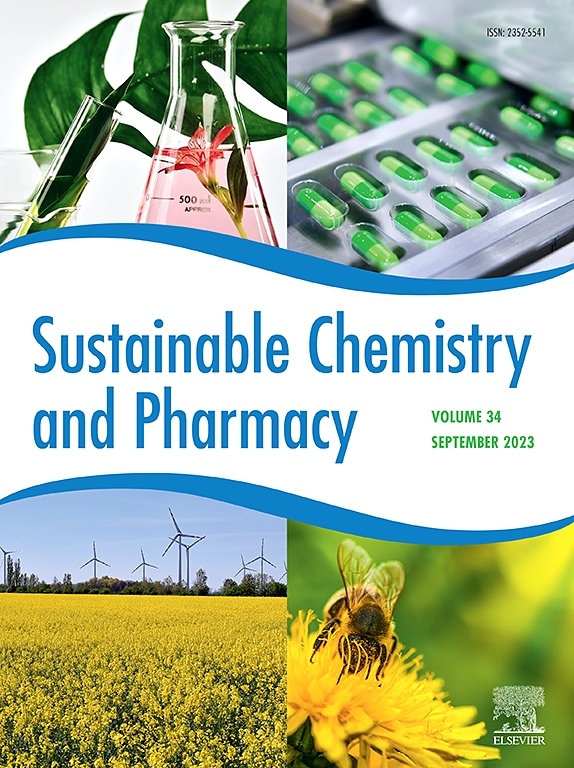Flexible and cleaner alkaloid extraction of Sophora Flavescens and Heterosmilax Japonica with the aid of process analytical technology
IF 5.5
2区 化学
Q2 CHEMISTRY, MULTIDISCIPLINARY
引用次数: 0
Abstract
Traditional alkaloid extraction processes (AEP) usually utilize large amount of organic reagents or acidic solvents, which produces considerable toxic/acidic solid and liquid waste. In order to make AEP cleaner, we take the extraction process of Sophora Flavescens and Heterosmilax Japonica as an instance and introduce process analytical technology (PAT) to analyze and improve the process. Specifically, we use near infrared spectroscopy (NIRS) to collect the process information. By combining NIRS data with online sampling and off-line high-performance liquid chromatography (HPLC) measurements, we find the hot leaching process (HLP) of the traditional AEP is quite inefficient and the extraction is quite incomplete. Hence, we make corresponding modifications to the process, including dropping the HLP step and introducing a three-phase static leaching step. Furthermore, we build predictive models using the NIRS and HPLC data in order to offer timely predictions of critical quality attributes (CQA), which makes it possible to perform dynamic controlling actions. With the help of PAT, we finally achieve flexible AEP which is cleaner and has higher extraction rate ( more) and lower solvent consumption ( less) than the traditional AEP. The flexible AEP also has much shorter processing time ( less), which can lead to better energy consumption.

用工艺分析技术灵活、清洁地提取苦参和杂花生物碱
传统的生物碱提取工艺通常使用大量的有机试剂或酸性溶剂,产生大量的有毒/酸性固体和液体废物。为了使AEP更清洁,以苦参和杂花的提取工艺为例,引入过程分析技术(PAT)对其进行分析和改进。具体来说,我们使用近红外光谱(NIRS)来收集过程信息。通过将近红外光谱(NIRS)数据与在线采样和离线高效液相色谱(HPLC)测量相结合,我们发现传统的AEP热浸工艺(HLP)效率低下,提取不完全。因此,我们对该工艺进行了相应的修改,包括取消HLP步骤,引入三相静态浸出步骤。此外,我们利用近红外光谱和高效液相色谱数据建立了预测模型,以便及时预测关键质量属性(CQA),从而可以执行动态控制操作。在PAT的帮助下,我们最终获得了柔性AEP,它比传统的AEP更清洁,提取率更高(约65%),溶剂消耗更低(约23%)。柔性AEP还具有更短的处理时间(减少约60%),这可以带来更好的能源消耗。
本文章由计算机程序翻译,如有差异,请以英文原文为准。
求助全文
约1分钟内获得全文
求助全文
来源期刊

Sustainable Chemistry and Pharmacy
Environmental Science-Pollution
CiteScore
8.20
自引率
6.70%
发文量
274
审稿时长
37 days
期刊介绍:
Sustainable Chemistry and Pharmacy publishes research that is related to chemistry, pharmacy and sustainability science in a forward oriented manner. It provides a unique forum for the publication of innovative research on the intersection and overlap of chemistry and pharmacy on the one hand and sustainability on the other hand. This includes contributions related to increasing sustainability of chemistry and pharmaceutical science and industries itself as well as their products in relation to the contribution of these to sustainability itself. As an interdisciplinary and transdisciplinary journal it addresses all sustainability related issues along the life cycle of chemical and pharmaceutical products form resource related topics until the end of life of products. This includes not only natural science based approaches and issues but also from humanities, social science and economics as far as they are dealing with sustainability related to chemistry and pharmacy. Sustainable Chemistry and Pharmacy aims at bridging between disciplines as well as developing and developed countries.
 求助内容:
求助内容: 应助结果提醒方式:
应助结果提醒方式:


